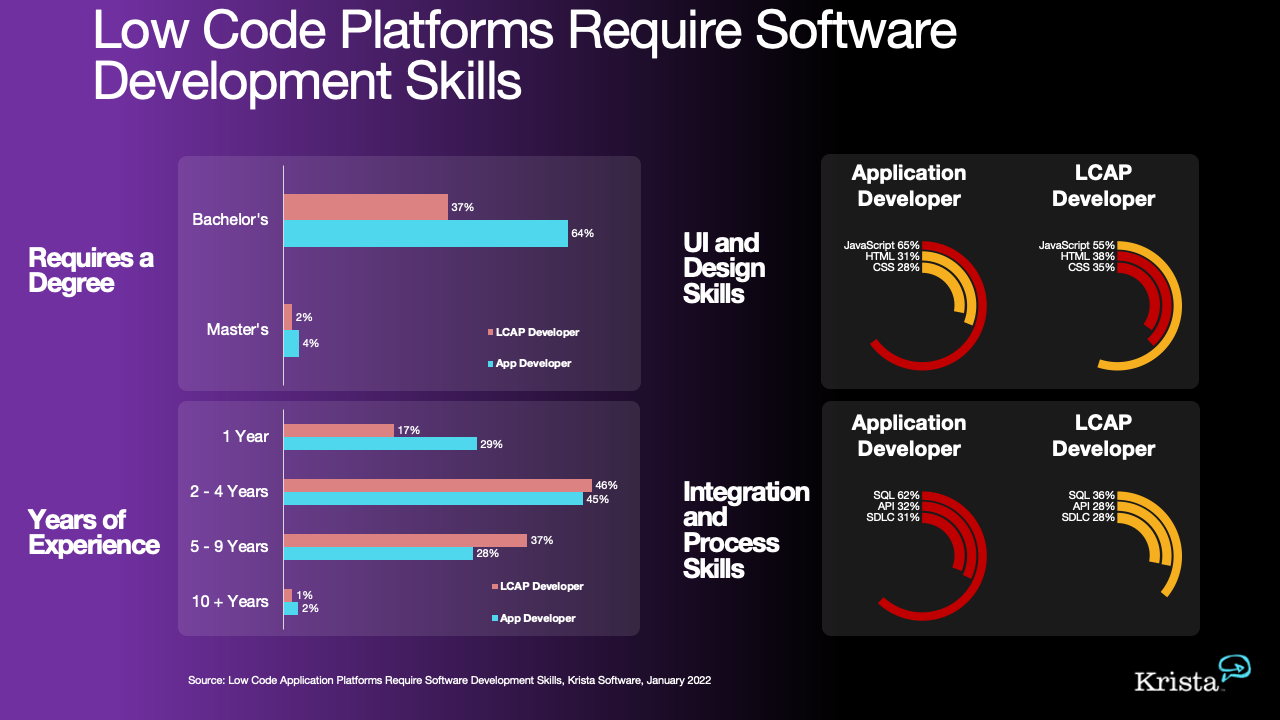Low Code Platforms Require Software Development Skills
A review of 400 LinkedIn job postings found low code application platforms require just as many software development skills as custom application development.
Join the DZone community and get the full member experience.
Join For FreeWhy it matters: IT leaders seeking to democratize technology with low code citizen developer projects may not realize low code platforms still require application development skills.
The big picture: Regardless of required development effort, building more apps for workers to contend with increases complexity and builds technical debt.
- Compared 400 application development and low code job opportunities on LinkedIn.
- More Low Code Application Platform jobs require UI and design skills.
- Nearly a third of low code jobs require SDLC knowledge or Agile experience.

One of our customers asked our CEO, John Michelsen, how much easier low code application platforms, (LCAP), are to use when building new apps. John informed them that low code platforms require skilled developers even though they market themselves as easier to develop apps. They questioned his quick response and assumed these platforms simplified app development. So, to settle the debate, I scraped job postings from LinkedIn to compare job openings for custom application development and those requiring low code platform experience.
I reviewed 400 different job postings on LinkedIn for application developers [link to data]. Two hundred of the job posts specifically asked for low code application developers with experience in Appian, OutSystems, Microsoft, Mendix, ServiceNow, Salesforce, or Oracle. The remaining 200 jobs sought application developers and didn’t specify a platform. Here is what I found.
Low Code Platform Education Requirements
First, I looked for required education credentials and years of experience. Sixty-four percent (64%) of the application development jobs required a bachelor’s degree as opposed to only thirty-seven percent (37%) of low code jobs requiring a degree.
I then looked at the required years of experience. It was interesting that jobs seeking low code application developers asked for more experience on average than those not developing in a specific platform.
Required Design and UI Skills for Low Code Platforms
Many of the job postings listed specific UI and design skills. The low code job postings actually state more HTML, CSS, and JavaScript skills requirements. Thirty-one percent (31%) of application development jobs in our sample require HTML, and thirty-eight percent (38%) of the low code jobs require these skills. More than a third (35%) of the LCAP job postings require CSS experience. Most of the jobs in both categories require JavaScript. With so much emphasis on design and usability, it’s clear companies still need too much human interaction to automate processes.
Low Code Platforms Require SDLC Knowledge
After reviewing UI requirements, I noticed many of the jobs require process and integration skills. Many of the jobs in our sample required API knowledge. Thirty-two percent (32%) of application developer jobs require API experience and twenty-eight percent (28%) of low code jobs require it. About a third of jobs (31% for App Dev, 28% for LCAP) in both sets require software development lifecycle or agile process knowledge. Process knowledge is essential because IT leaders understand these apps take time to build, and therefore, they need experience in agile methodologies.
After reviewing 400 application development jobs and those requiring specific experience with low code platform development platforms, I found low code platforms require just as much or more skills than custom application development.
Are low code platforms democratizing technology if they require so many technical skills?
Low Code Isn’t No Code
Companies need to look at alternatives rather than building more apps with low code platforms to truly democratize technology. Who needs more apps anyway? Businesses are already overwhelmed with the burgeoning list of apps in the workplace. An enterprise uses 397 apps on average. These apps have separate user interfaces and terminology, functional features, license costs, and/or a development team with a backlog of change and support requests. More apps increase costs and frustrate employees. The average employee trying to manage processes through all of these apps switches between 35 job-critical applications more than 1,100 times every day.
All of these apps aren't your fault, though. The business asks for them, and you deliver. The business actually wants an easier way to perform digital tasks, produce digital outcomes, and eventually operationalize machine learning.
Intelligent Automation Orchestrates Processes, People, and AI
If enterprises want more digital capabilities, leaders at these companies need to take a step back and get a broader view. Another app isn't going to solve your problem or reduce complexity for the people that work there. What they need to realize is they want better results. Maybe if you digitize the entire process instead of just a task, you can see where the bottlenecks are.
This is intelligent automation. Building intelligent automation is intuitive and doesn't require technical skills. Therefore, process owners can edit automation in minutes, not months, to avoid waiting for overworked developers. Intelligent automation also reduces complexity for people who work inside the company since more work shifts to software instead of manual data entry inside a bunch of apps. Most importantly, building automation in a single platform structures data and provides a straightforward way to introduce machine learning.
Published at DZone with permission of Scott King. See the original article here.
Opinions expressed by DZone contributors are their own.

Comments